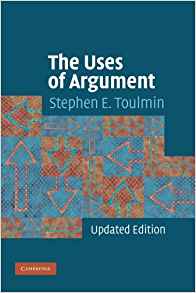Since this is my first one of these, the title of this post is rather optimistic. However, I am trying to trick myself into reading more, so ssshhhh…
The honor as the inaugural recipient of my book of the month review prize is Stephen Toulmin’s “The Uses of Argument”.
I recently shared some thoughts with a colleague who happens to also be a graduate student. I cannot think of a better book recommendation for any graduate student and for any researcher than Toulmin’s excellent book.
I wish I would have read this book, or any of Toulmin’s books, many years earlier. I was introduced to this book by Dr Yair Levi when I took a doctoral course in systems engineering (out of all things). From the researcher/student perspective, it was life-changing. Toulmin’s book is quite philosophical, and it certainly reminded me what the “Ph” in PhD represents.
The book presents a structural model for presenting arguments based on facts, backing, and reason, among other concepts. The book is full of colorful examples and it is very readable. Do not expect to follow it like a recipe book. Simply absorb and embrace the philosophy and the environment presented by the book and try to consciously apply those concepts to how you formulate arguments.
In my opinion, one of the most important steps when embarking on any research, or enterprise for that matter, is properly stating the problem. Therefore, understanding how to logically model an argument is key to driving things forward.
After reading this book I found myself applying these concepts to my own everyday job. I will let you in on some of my secret methods. I actually developed my own simple technique based on Toulmin’s model for formulating arguments by using yellow stickies. My wife likes to decorate my office walls with maps, etc. and those just happen to be the perfect surfaces to brainstorm and “frame” (get it?) some ideas:
The only minor issue I have with this book is that it reads like a collection of lecture notes. That is, there is no real beginning, middle, and end. Well, there is a progression to the ideas presented but, like in a textbook, the heavy lifting happens in the reader’s head. This is a very minor point, because the book is a must-read for any researcher or professional. I highly recommend it.



